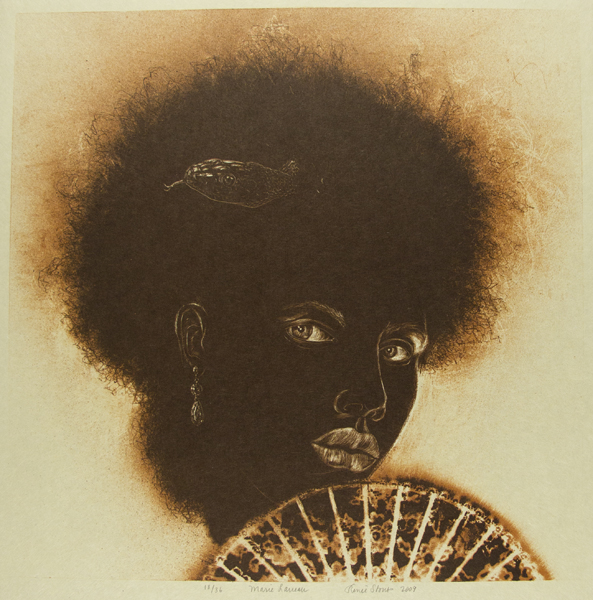Visual Literacy is the process of reading images to understand meaning from them. This is done regularly as we see signs, interpret body language, watch films, and view art, to name just a few applications.
Like all skills, Visual Literacy is developed through practice. We will be using a step by step process developed by Edmund Burke Feldman to offer helpful tips on approaching and reading art!

Reading Art: Artist Introduction
Through Visual Literacy, we will explore a print from the Museum Permanent Collection by American artist Renee Stout.
This piece was purchased in 2016 by the Museum’s Collectors Circle, whose goal since its inception in 2009 is to strengthen the collection in both depth and variety. You may have seen this print at the museum last year, in an exhibition co-curated with Cammie Dean, MSU’s director of First2Go and The Priddy Scholars. Ms. Stout uses a wide range of media to explore her African American heritage, the African Diaspora, and everyday life to encourage self examination, empowerment, and healing. In her words she is “…telling the story of who we are as a society at this point in time.” The next four posts in this series explore ways of reading art: Observation, Analysis, Interpretation, and Evaluation, all featuring Stout’s 2009 color lithograph titled “Marie Laveau.” We invite you to use each post to help guide your process of creating meaning with this piece.
Reading Art: Analysis
The second step in reading art is Analysis. Where observation identifies the subjects present in a work of art, Analysis instead focuses on the visual relationships between those elements and how they work together to form a composition. Does this artwork show signs of balance, unity, variation, proportion, scale, emphasis, and/or rhythm? Having an understanding of these Principles of Design can reveal the artist’s decision making process and intended communication.
Reading Art: Observation
Our first step in reading art, Observation, is all about gathering details to help later form an interpretation. Carefully study the work of art before you, no detail is too small. What do you see? Sometimes it can be helpful to ask who, what, when, or where is being shown? Only note what you know for sure. Which subjects are present? How is line, shape, form, space, value, color, and texture used in this piece?
Reading Art: Interpretation
Art can be used to tell stories, record and commemorate, share experiences, give tangible form to concepts like emotion, and so much more! In short, art is made with intention. Our third step in reading art, Interpretation, is used to determine what that intention might be. Interpretation is based on ideas, feelings, and outside information that is known or researched. Your Observation and Analysis done in earlier stages, will inform part of your Interpretation. What is the artist sharing? Is there a main idea that is stated? Is there a theme? What makes you say so?
-
Tuesday - Friday
10:00AM - 5:00PMSaturday
1:00PM - 5:00PM